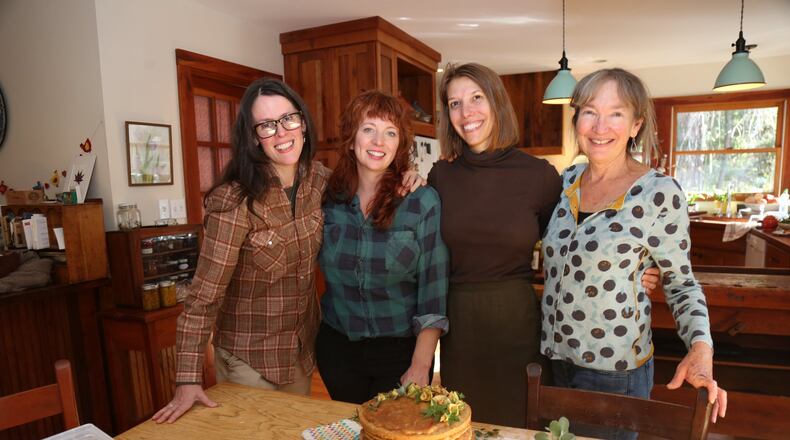ASHEVILLE, N.C. — The door to the log cabin kept opening and closing.
Ashley English walked in first. Her 2-year-old toddler was a mad man, said the harried mother of two, shutting the door behind her.
Ashley Capps arrived soon afterward, lugging baking necessities. She set the bags down on the wood floor and scanned the scene. A soft-spoken Susannah Gebhart looked like a Vogue model with her newly cut shoulder-length hair tucked under a beige wool cap and vintage boots laced to just below her knees. Proprietress Barbara Swell was uncomfortable posing for a photo in front of her 1928 wood-fired stove that she uses to teach classes on Appalachian cookery and general homestead scrappiness. She was, however, at ease in welcoming these familiar faces to her log cabin.
English and Swell have each published 11 cookbooks, ranging in subject from pies to picnics. You could call them twins, were it not for their 20-year age difference. Capps is a James Beard-nominated pastry chef who most recently managed all things baked for popular Asheville barbecue joint Buxton Hall. Gebhart is a scholar-turned-bread baker who now employs a staff of more than two dozen at her progressive Old World Levain (OWL) Bakery in Asheville.
Although they’ve lived in the same city for years, the four culinarians had never cooked together.
They gathered at Swell’s house that fall afternoon to prepare an apple stack cake, an Appalachian dessert comprised of a thick, dried apple filling spread between layer upon layer of thin, sorghum-sweetened, mildly ginger-flavored cakes. Once stacked and slathered, the mile-high cake is left to “cure” a few days before being eaten.
As Mark F. Sohn explains in “Appalachian Home Cooking: History, Culture, and Recipes”: “The cake was popular because five of the essential ingredients — dried apples, lard, sorghum, buttermilk, and eggs — were grown and prepared on the farm, and the others — spices, flour, and baking soda — could be purchased in local markets. Today, mountaineers romanticize this cake because it stands out as one of the region’s special creations.”
The celebratory cake is “super regional,” the women emphasized repeatedly during the baking session. Hundreds of recipes exist.
“I don’t know how authentic we have to be,” Swell said. After all, this stack cake would be an adaption of an adaptation of a recipe that Gebhart had collected as part of the oral history initiative Appalachian Food Storybank she founded in 2011.
Which flour for the cake? Swell asked, ticking off the options in her larder. Everyone quickly settled on Carolina Ground from the Asheville flour mill that Jennifer Lapidus launched in 2012.
How do we feel about less sugar? Head nods.
Capps was busy at the stove preparing the dried apple filling. Some might cook it down to an applesauce consistency, but Capps preferred a slightly chunky texture. Should we add Calvados? Heads nodded in approval. Yes, spike it with apple brandy.
If you Google “stack cake,” lore will tell you that Appalachian womenfolk each brought a layer to a social function and assembled it on-site. These women don’t buy into that.
“Maybe the lore got adopted as truth,” English said.
Some cooks do not adorn the top of the cake. Others dust it with powdered sugar. This cake would reflect the sensibilities of four women who have been instrumental in documenting and celebrating the ever-evolving Appalachian foodways.
Capps began wrapping dried apples around her finger, shaping them into roses. Swell grabbed scissors, walked out to her garden and returned with a handful of lemon verbena, sage, rosemary and raspberries. They took turns tucking the greenery under and around the delicate faded yellow petals, working by feel and sight. Capps gently pulled apart a single raspberry, positioning the tiny red orbs where it felt just right.
“This cake is beautiful, but to me, it’s because we made it together,” Capps said.
Apple Stack Cake
“Each family and community has their own idea of what an apple stack cake should look and taste like,” says Barbara Swell of Asheville. Add spices to the cake batter or the apple filling, if you wish. This recipe, adapted from one by Zara J. Walker of Bryson City, is less sweet than average stack cakes. Buttermilk, however, is still a necessity.
For the apple filling:
1 pound dried apples
Apple cider to cover
1/4 cup brown sugar (or more to taste)
1 teaspoon cinnamon
Pinch salt
For the cake layers:
1 3/4 sticks unsalted butter, softened
1/2 cup sorghum syrup or molasses
3/4 cup brown sugar
2 eggs
1/2 cup buttermilk
5 cups all-purpose flour
1 teaspoon baking powder
1/2 teaspoon baking soda
1 teaspoon salt
1/2 teaspoon ginger (optional)
1/2 teaspoon cinnamon (optional)
Pinch nutmeg (optional)
Pinch allspice (optional)
Prepare the apple filling: Place the dried apples in a large pot and pour enough cider to cover. Bring to a simmer and allow the apples to hydrate and cook, adding more cider or water as needed to keep from sticking. After about 30 minutes, stir in the brown sugar, cinnamon and salt and continue to cook until the apples break down and thicken somewhere between applesauce and apple butter (there will still be some chunks). Set aside.
Prepare the cake layers: Cream the butter and add the sorghum syrup and brown sugar. Beat until fluffy. Add the eggs and buttermilk. In a separate bowl, combine the flour, baking powder, baking soda, salt and optional spices and stir well. With your hands or a spatula, add the flour mixture in 2 parts to the butter mixture. Fold until incorporated. The batter will be stiff like cookie dough. Wrap the dough in plastic wrap and chill in the refrigerator for at least 30 minutes until firm. Divide the dough into 6 balls. On a lightly floured piece of parchment paper, roll out into about 1/8-inch-thick circles that are about 9 inches in diameter. Use the bottom of a cake pan as a template to cut an even circle. Collect dough scraps and reroll. You will have between 6 and 8 cake layers depending on how thick you roll your dough. Place parchment paper with dough rounds on cookie sheets and bake at 350 degrees until cakes are lightly browned. They will still be a little spongy.
After the cake layers have cooled, place one on a plate, spoon some of the warm apple mixture on and spread in a thin layer evenly over the surface. Add another cake and repeat, stacking up the layers. You’ll leave the top bare for now, but reserve 1 cup of the apple mixture for serving. Wrap the cake well and refrigerate for a day or two. The cake will soak up the juices from the apples. Before serving, top cake with remaining apple mixture. Serves 12-15.
Per serving, based on 12: 453 calories (percent of calories from fat, 25), 7 grams protein, 79 grams carbohydrates, 5 grams fiber, 13 grams fat (8 grams saturated), 67 milligrams cholesterol, 346 milligrams sodium.
RELATED:
Read more stories like this by liking Atlanta Restaurant Scene on Facebook, following @ATLDiningNews on Twitter and @ajcdining on Instagram.
About the Author
Keep Reading
The Latest
Featured










